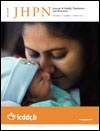Prevalence of Vitamin A Deficiency in Pregnant and Lactating Women in the Republic of Congo
DOI:
https://doi.org/10.3329/jhpn.v31i1.14746Keywords:
Dried blood spots, Lactating women, Pregnant women, Vitamin A deficiency, CongoAbstract
Vitamin A status in a sample of pregnant and lactating women living in several representative regions of Congo was assessed and compared between August and September 2004. This survey was conducted using a randomized two-stage cluster-sampling method with stratification on 90 clusters, each consisting of at least 15 women. Vitamin A status was determined in a total of 1,054 individuals, using the impression cytology with transfer (ICT) test, the modified relative dose response test (MRDR test) on dried blood spots (DBS), and clinical examination to detect signs of xerophthalmia. The clinical criterion defining vitamin A deficiency was the presence of active xerophthalmia (Bitots spots [X1B]), active corneal disease), and/ or night blindness (XN stage). The prevalence of clinical signs of stage XN and X1B xerophthalmia in the Republic of Congo was found to be 16% and 19% respectively. The prevalence of clinical signs (X1B) was greater in the rural north than in urban areas, with a gradient running from urban (5%) to rural area (33%); 27% of all the ICT tests showed that the subjects were suffering from vitamin A deficiency. The deficiency rates were significantly higher (p<0.001) in urban surroundings (Brazzaville) than in the rural northern regions. The biochemical MRDR test showed the presence of vitamin A deficiency (?0.06) in 26% of the mothers in Brazzaville compared to 6% in the town of Kouilou; 44% of the women had retinol levels of <10 ?g/dL in the rural north whereas these percentages were significantly lower in the urban areas surveyed (chi-square=62.30, p<0.001). A significant correlation was found to exist (p<0.001) between the ICT test and the MRDR test on DBS. In the population as a whole, 30% of the mothers suffering from malarial attack had abnormally low MRDR levels (?0.06) compared to no malaria. The results of the present study confirm that vitamin A deficiency is a serious public-health issue in pregnant and lactating mothers in the Republic of Congo.
J HEALTH POPUL NUTR 2013 Mar;31(1):28-36
Downloads
878
561

